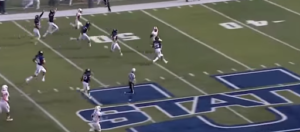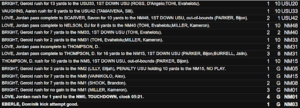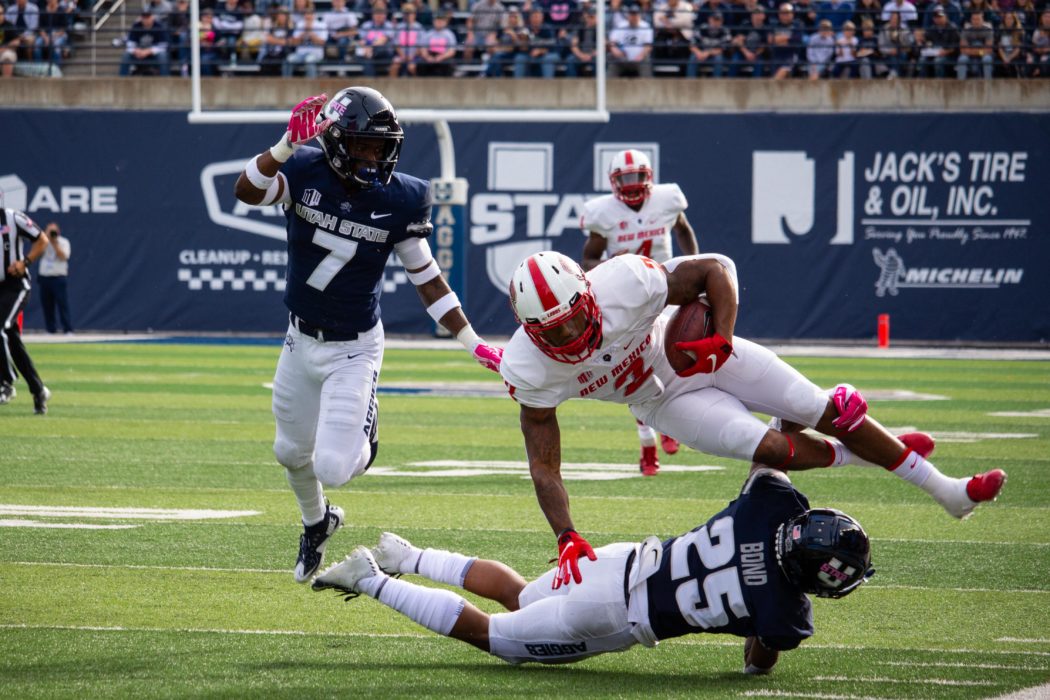Underappreciated All-Stars: Utah State vs. New Mexico
Football is often referred to as the ultimate team sport, yet we often only focus on a handful of players as the key to a recent victory, and even among those players we only recognize a handful of plays. In reality, there are countless numbers of players and unseen plays that are absolutely crucial to a team’s success, yet these rarely receive the recognition their play deserves. Every facet of the game has these underappreciated all-stars, and this column seeks to recognize them. After every Aggie game, we’ll take a look back, win or loss, at the unheralded players responsible for Utah State’s success. These are the Underappreciated All-Stars.
Shaq Bond’s 100-yard INT return
Momentum is the most important part of a football game. Teams practice inertia, meaning that once a team makes a big play, the likelihood they create another increases. I have no numerical data to prove that, but we do have USU’s performance versus New Mexico. The Lobos actually looked okay through the first several minutes. After a 3-and-out on USU’s first possession, the Aggie offense ignited on their second for another fast-paced touchdown drive, but the Lobos have already tacked on a 53-yard field goal on their first drive and followed that with a long, methodical drive on their second that moved the team into the red zone. New Mexico was threatening to turn this into an actual game at this point, by taking a firm punch from USU’s offense and answering with a hey-maker of their own.
Sophomore safety Shaq Bond puts a quick end to that, and starts in earnest the onslaught of 49 unanswered points for Utah State. The momentum shifted monumentally here, but Bond wasn’t the only reason why. Junior defensive end Dalton Baker deserves a fair amount of credit here for not biting on the play fake and immediately closing in on UNM QB Sheriron Jones. With that pressure, Jones is forced to throw on the run, and the throw goes off target. There is some room for the throw, but Jones’ throw drifts inside and allows Bond to catch up and make the play.
There’s a reason Utah State scores non-offensive touchdowns at a blazing rate. It’s because the entire team works for them. Look at @ShaquezBond‘s 100-yard INT return. Before he even gets to midfield on the return, he already has 6 other Aggies in his caravan versus only 2 Lobos. pic.twitter.com/cJgsGJYKGH
— Daniel Hansen (@TheGrandDanny) November 1, 2018
Even after the interception, there’s still a great amount of work left for Bond to score, about 100 yards to be exact. Here’s where Utah State’s effort simply overcomes New Mexico.

Bond is barely crossing midfield here. Take a look at how many Aggie defenders are making this 100-yard run with Bond. There are six Aggies within 10 yards of the play, compared to only two Lobos trying to make a touchdown-saving tackle. Bond simply has to slow down enough to allow his blockers into the play, which is also a smart play which can be difficult to do in the moment. This is a full team touchdown. That’s why Utah State ranks among the nation’s best in scoring non-offensive touchdowns. It takes a full team to make those plays and USU plays as a full team.
Finally a long touchdown drive
Utah State’s offense is historically prolific. No Aggie offense has ever averaged over 40 points per game for a season. Currently, USU sits at 49.4 points per game, third-best in the nation. But if the Aggies have one offensive flaw, it’s been their inability to sustain long drives. Or rather, it’s been their incredible offensive efficiency that’s removed the necessity to sustain long drives in order to score. Utah State scores quickly and with relative ease, ranking second in the country with 17 touchdowns drives of one minute or less. That shot-out-of-a-cannon ability results in the kinds of dominant stretches we’ve seen this far, such as the 49 unanswered points versus New Mexico.
It can also lead to the defense being on the field for a greater percentage of the game. Saturday was only the third time the Aggies have won the time of possession battle, despite being in firm control nearly every game so far this season. USU only averages about 26:52 of possession per game, leaving the defense exposed to fatigue in certain matchups. So much of USU’s offense is predicated on speed in between plays, not allowing the defense to substitute or prepare for a play. Chunk yardage is the name of the game, methodically moving the ball and converting on second- and third-down situations is not.
Except for the second quarter versus New Mexico. Utah State pieced together a 13-play, 80-yard touchdown drive that took over five minutes of gametime off the clock.

Those kinds of drives will be paramount in matchups versus Boise State and a possible MW title game versus Fresno State. Both opponents field offenses that can overpower and pick apart a defense, and both rank in the top 40 in the nation for time of possession. Utah State’s offense certainly has the power to keep pace with either offense, but a fatigued defense could make that ability moot. USU’s defense will need at least several minutes at various points through the game to recover, and Utah State’s 5-minute drive on Saturday is the blueprint for that to happen.
Dax Raymond and Carson Terrell: Two-headed beast
We already knew what we had in Dax Raymond entering the season: possibly the best tight end in the conference. Carson Terrell was more of a question mark after an up-and-down freshman year. But with Raymond missing the past few weeks, Terrell entered the proving grounds and filled in nicely. Now that Raymond’s back on the field, the Aggies can deploy two tight ends over 6-foot-4 and 245 pounds with athleticism, speed, agility, and solid hands. Utah State has a legitimate claim that two of the conferences five best tight ends in the MW call Logan home. The pair are walking mismatches and defenses have to account for both, which results in plays like this.
Getting @dax_raymond is a huge boost to an already potent offense. Raymond’s a walking mismatch, but him missing a few weeks might turn into a blessing for the Aggies, because it gave a lot more reps to @carsonT88. Now, defenses have to guard this… pic.twitter.com/ot2lI4Gnpn
— Daniel Hansen (@TheGrandDanny) November 1, 2018
Raymond is too big for most cornerbacks and safeties to cover him and too quick for linebackers to keep with him either. Oh yeah, same for Terrell.
… and this. Raymond might be the best tight end in the conference, and Terrell is putting together a really good case to be in the Top 5 conversation. And defenses have to gameplan for both of them. This offense is an embarrassment of riches. pic.twitter.com/jcPoG2O04V
— Daniel Hansen (@TheGrandDanny) November 1, 2018
This year is a perfect storm for Utah State’s offense. The offensive coordinator has implemented an incredibly effective offensive scheme, and the Aggies have a glut of talent that’s had the time to learn the system and exploit it. Raymond and Terrell are a prime example.

